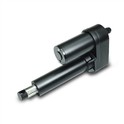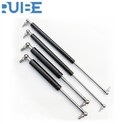Hey there! As a supplier of Bonnet Gas Springs, I've seen firsthand how crucial it is to get the alignment right during installation. A misaligned gas spring can lead to all sorts of problems, from reduced performance to premature wear and tear. In this blog post, I'm going to share some tips on how to ensure the correct alignment of a Bonnet Gas Spring during installation.
Understanding the Basics
Before we dive into the installation process, let's take a quick look at what a Bonnet Gas Spring is and how it works. A Bonnet Gas Spring is a type of gas spring that is commonly used in automotive applications, such as hoods and trunks. It consists of a cylinder filled with gas, a piston rod, and a mounting bracket. When the piston rod is compressed, the gas inside the cylinder is compressed, creating a force that helps to lift and support the weight of the bonnet or trunk.
Pre-Installation Checks
Before you start installing the Bonnet Gas Spring, it's important to do some pre-installation checks to ensure that everything is in order. Here are some things to check:
- Compatibility: Make sure that the Bonnet Gas Spring you have is compatible with your vehicle. Check the specifications of the gas spring and compare them to the requirements of your vehicle.
- Condition: Inspect the Bonnet Gas Spring for any signs of damage or wear. Look for leaks, dents, or other visible defects. If you notice any problems, do not use the gas spring and contact the supplier for a replacement.
- Mounting Points: Check the mounting points on your vehicle to make sure that they are clean, free of debris, and in good condition. If the mounting points are damaged or worn, they may need to be repaired or replaced before installing the gas spring.
Installation Process
Once you have completed the pre-installation checks, it's time to start installing the Bonnet Gas Spring. Here are the steps to follow:
- Position the Bonnet: Open the bonnet and position it in the fully open position. Make sure that the bonnet is stable and secure before proceeding.
- Locate the Mounting Points: Locate the mounting points on the bonnet and the vehicle frame. The mounting points are usually marked with a small hole or a groove.
- Attach the Gas Spring: Attach one end of the Bonnet Gas Spring to the mounting point on the bonnet using the appropriate mounting hardware. Make sure that the gas spring is securely attached and that the mounting hardware is tightened to the recommended torque.
- Attach the Other End: Attach the other end of the Bonnet Gas Spring to the mounting point on the vehicle frame using the appropriate mounting hardware. Make sure that the gas spring is securely attached and that the mounting hardware is tightened to the recommended torque.
- Check the Alignment: Once the Bonnet Gas Spring is attached, check the alignment to make sure that it is straight and parallel to the bonnet. If the gas spring is not aligned correctly, it may cause the bonnet to open or close unevenly, or it may put extra stress on the gas spring, leading to premature wear and tear.
- Test the Gas Spring: After the Bonnet Gas Spring is installed and aligned correctly, test it to make sure that it is working properly. Open and close the bonnet several times to make sure that the gas spring is providing the correct amount of support and that the bonnet is opening and closing smoothly.
Tips for Ensuring Correct Alignment
Here are some tips to help you ensure the correct alignment of a Bonnet Gas Spring during installation:
- Use a Alignment Tool: A alignment tool can help you to ensure that the Bonnet Gas Spring is installed in the correct position and at the correct angle. You can purchase a alignment tool from your local automotive parts store or online.
- Follow the Manufacturer's Instructions: Always follow the manufacturer's instructions when installing a Bonnet Gas Spring. The instructions will provide you with the specific steps and torque values that you need to follow to ensure a proper installation.
- Take Your Time: Installing a Bonnet Gas Spring can be a bit tricky, so it's important to take your time and do it right. Rushing through the installation process can lead to mistakes and may result in a misaligned gas spring.
- Seek Professional Help: If you're not comfortable installing a Bonnet Gas Spring yourself, or if you're not sure how to do it correctly, seek professional help. A qualified mechanic or automotive technician can install the gas spring for you and ensure that it is aligned correctly.
Other Applications of Gas Springs
Bonnet Gas Springs are just one type of gas spring that we offer. We also supply gas springs for a variety of other applications, including Gas Spring for Tanning Bed, Gas Spring for Kitchen Cabinet, and Gas Lift for Furniture. These gas springs are designed to provide smooth and reliable operation in a variety of environments.
Conclusion
Ensuring the correct alignment of a Bonnet Gas Spring during installation is crucial for its performance and longevity. By following the tips and steps outlined in this blog post, you can ensure that your Bonnet Gas Spring is installed correctly and that it will provide reliable support for your vehicle's bonnet. If you have any questions or need further assistance, please don't hesitate to contact us. We're here to help you find the right gas spring for your application and to ensure that it is installed correctly.


References
- Gas Spring Manufacturer's Manual
- Automotive Repair Manuals






